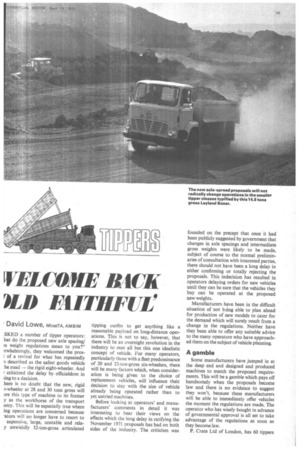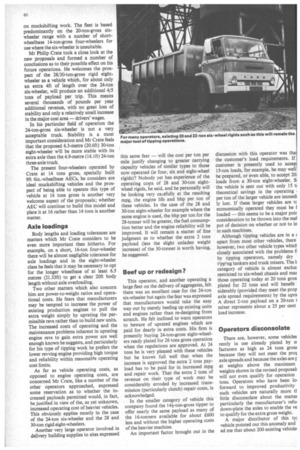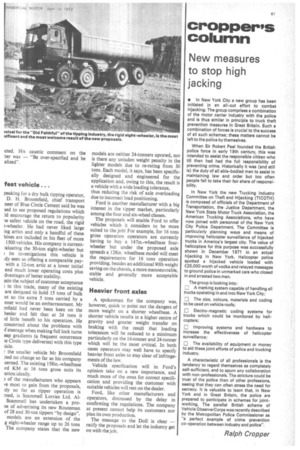[VIELCOME KICK MB FAITHFUL'
Page 61

Page 62

Page 63

If you've noticed an error in this article please click here to report it so we can fix it.
David Lowe, MInstTA AM BIM
.SKED a number of tipper operators: hat do the proposed new axle spacing/ ss weight regulations mean to you?" krwhelmingly, they welcomed the prosof a revival for what has repeatedly n described as the safest goods vehicle .he road — the rigid eight-wheeler. And criticized the delay by officialdom in king to a decision.
here is no doubt that the new, rigid It-wheeler at 28 and 30 tons gross will ore this type of machine to its former y as the workhorse of the transport istry. This will be especially true where ing operations are concerned because 'ators will no longer have to resort to • expensive, large, unstable and relay unwieldly 32-ton-gross articulated tipping outfits to get anything like a reasonable payload on long-distance operations. This is not to say, however, that there will be an overnight revolution in the industry to oust all but this one idealistic concept of vehicle. For many operators, particularly those with a fleet predominance of 20 and 22-ton-gross six-wheelers, there will be many factors which, when consideration is being given to the choice of replacement vehicles, will influence their decision to stay with the size of vehicle already being operated rather than to yet untried machines.
Before looking at operators' and manufacturers' comments in detail it was interesting to hear their views on the effects which the long delay in ratifying the November 1971 proposals has had on both sides of the industry. The criticism was founded on the precept that once it had been publicly suggested by government that changes in axle spacings and intermediate gross weights were likely to be made, subject of course to the normal preliminaries of consultation with interested parties, there should not have been a long delay in either confirming or totally rejecting the proposals. This indecision has resulted in operators delaying orders for new vehicles until they can be sure that the vehicles they buy can be operated at the proposed new weights.
Manufacturers have been in the difficult situation of not being able to plan ahead for production of new models to cater for the demand which will surely result from a change in the regulations. Neither have they been able to offer any suitable advice to the many operators who have approached themon the subject of vehicle planning.
A gamble
Some manufacturers have jumped in at the deep end and designed and produced machines to match the proposed requirements. This will be a gamble which pays off handsomely when the proposals become law and there is no evidence to suggest they won't, because these manufacturers will be able to immediately offer vehicles the moment the regulations are made. The operator who has wisely bought in advance of governmental approval is all set to take advantage of the regulations as soon as they become law.
P. Crate Ltd of London, has 60 tippers on muckshifting work. The fleet is based predominantly on the 20-ton-gross sixwheeler range with a number of shortwheelbase 14-ton-gross four-wheelers for use where the six-wheeler is unsuitable.
Mr Philip Crate took a close look at the new proposals and formed a number of conclusions as to their possible effect on his future operations. He welcomes the prospect of the 28/30-ton-gross rigid eight, wheeler as a vehicle which, for about only an extra 4ft of length over the 24-ton six-wheeler, will produce an additional 4/5 tons of payload per trip. This means several thousands of pounds per year additional revenue, with no great loss of stability and only a relatively small increase in the major cost area — drivers' wages.
In his particular field of operation the 24-ton-gross six-wheeler is not a very acceptable truck. Stability is a most important consideration and Mr Crate feels that the proposed 6.3-metre (20.6ft) 30-ton eight-wheeler will be more stable with its extra axle than the 4.9-metre (16.1ft) 24-ton three-axle truck.
The present four-wheelers operated by Crate at 14 tons gross, specially built 9ft 6in.-wheelbase AECs, he considers are ideal muckshifting vehicles and the prospect of being able to operate this type of vehicle at 16 tons gross is another very welcome aspect of the proposals; whether AEC will continue to build this model and plate it at 16 rather than 14 tons is another matter.
Axle loadings
Body lengths and loading tolerances are matters which Mr Crate considers to be even more important then hitherto. For example, on a short, 16-ton four-wheeler there will be almost negligible tolerance for axle loadings and in the eight-wheeler class he feels that it may be necessary to opt for the longer wheelbase of at least 6.5 metres (21.33ft) to get a clear 20ft body length without axle overloading.
Two other matters which also concern him are power-to-weight ratios and operational costs. He fears that manufacturers may be tempted to increase the power of existing production engines to pull the extra weight simply by uprating the permissible revs rather than to build new units. The increased costs of operating and the maintenance problems inherent in uprating engine revs to gain extra power are well enough known he suggests, and particularly for his type of tipping work he prefers the lower revving engine providing high torque and reliability within reasonable operating cost limits.
As far as vehicle operating costs, as opposed to engine operating costs, are concerned Mr Crate, like a number of the other operators approached, expressed some reservation as to whether the increased payloads permitted would, in fact, be justified in view of the, as yet unknown, increased operating cost of heavier vehicles. This obviously applies mostly in the case of the 24-ton six-wheeler and the 28 and 30-ton rigid eight-wheelers.
Another very large operator involved in delivery building supplies to sites expressed this same fear — will the cost per ton per mile justify changing to greater carrying capacity vehicles of similar types to those now operated (ie four, six and eight-wheel rigids)? Nobody yet has experience of the operating co§ts of 28 and 30-ton eightwheel rigids, he said, and he personally will be looking very caiefully at the resulting mpg, the engine life and bhp per ton of these vehicles. In the case of the 28 and 30-ton eight-wheeler for example where the same engine is used, the bhp per ton for the 28-tonner will be greater, the fuel consumption better and the engine reliability will be improved. It will remain a matter of fine judgment as to whether the extra 2 tons payload (less the slight unladen weight increase) of the 30-tonner is worth having, he suggested.
Beef up or redesign?
This operator, and another operating a large fleet on the delivery of aggregates, felt there was an excellent case for the 24-ton six-wheeler but again the fear was expressed that manufacturers would take the easy way out by merely beefing up existing units and engines rather than re-designing from scratch. He felt inclined to warn operators to beware of uprated engines which are paid for dearly in extra costs. His firm is presently buying 24-ton-gross eight-wheelers ready plated for 26 tons gross operation when the regulations are approved. At 24 tons he is very pleased with these vehicles but he knows full well that when the increase is approved the extra 2 tons payload has to be paid for in increased mpg and repair work. That the extra 2 tons of revenue on their type of work may be considerably erroded by increased transmission (particularly clutch) repair costs, is acknowledged.
In the smaller category of vehicle this company found the 14+-ton-gross tipper to offer nearly the same payload as many of the 16-tonners available for about £600 less and without the higher operating costs of the heavier machine.
An important factor brought out in the discussion with this operator was tha the customer's load requirements. If customer is presently used to accep 15-ton loads, for example, he may well be prepared, or even able, to accept 20 loads from a 30-ton eight-wheeler. S the vehicle is sent out with only 15 t! theoretical savings in the operating I per ton of the larger vehicle are immecli ly lost. If these larger vehicles are tc economically operated they must be I loaded — this seems to be a major poir consideration to be thrown into the mel pot of decision on whether or not to in in such machines.
Although tipping vehicles are in a ( apart from most other vehicles, there however, two other vehicle types whict closely associated with the problems f by tipping operators, namely dry tlpOng tankers and truck mixers. The 1, category of vehicle is almost exclus restricted to six-wheel chassis and mar those operating today at 20 tons gros; plated for 22 tons and will benefit siderably (provided they meet the prop axle spread requirements) by the upra A direct 2-ton payload on a 20-ton 1 mixer represents about a 25 per cent load increase.
Operators disconsolate
There are, however, some vehicles rently in use already plated by n facturers as high as 24 tons gross because they will not meet the proj axle spreads and because the axles are r at weights above the maximum weights shown in the revised proposal; will not even qualify for operation tons. Operators who have been forward to improved productivity such vehicles are naturally more ti little disconsolate about the mattei particularly the manufacturer's refu: down-plate the axles to enable the ye to qualify for the extra gross weight.
A major distributor of this ty! vehicle pointed out this anomaly and ed me that about 200 existing vehicle: icted. His caustic comment on the tter was — "Be over-specified and be alized".
fest vehicle ...
peaking for a dry bulk tipping operator, D. H. Broomfield, chief transport neer of Blue Circle Cement said he was sed to see proposed regulations which Id encourage the return to popularity le safest vehicle on the road, the rigid t-wheeler. He had never liked large ing artics and only a handful of these hines are included in his fleet of more 1500 vehicles. His company is currentialuating the 30-ton eight-wheeler but t its investigations this vehicle is idy seen as offering a comparable paywith a 32-ton artic at a lower initial and much lower operating costs plus dvantages of better stability.
ain the subject of customer acceptance in this trade, many of the existing are designed to hold 15 tons of bulk nt so the extra 5 tons carried by a ,nner would be an embarrassment. Mr mfield had never been keen on the heeler and felt that at 24 tons it xl little benefit to his operation. He concerned about the problems with if steerage when making full lock turns eep gradients (a frequent occurrence le Circle type deliveries) with this type iicle.
r the smaller vehicle Mr Broomfield :led no change so far as his company cerned. The existing 158in.-wheelbase Td KM at 16 tons gross suits its iation ideally.
.t of the manufacturers who appears ve most to gain from the proposals, aly so far as tipper operation is rned, is Scammell Lorries Ltd. AlScammell has undertaken a prone of advertising its new Routeman of 28 and 30-ton tippers "by design". models are an extension of the .g eight-wheeler range up to 26 tons The company states that the new models are neither 24-tonners uprated, nor is there any unladen weight penalty in the lighter models due to re-rating from 30 tons. Each model, it says, has been specifically designed and engineered for the application and, owing to this, the result is a vehicle with a wide loading tolerance, thus reducing the risk of axle overloading due to incorrect load positioning.
Ford is another manufacturer with a big interest in the tipper market, particularly among the four and six-wheel classes.
The proposals will enable Ford to offer vehicles which it considers to be more suited to the jobi For example, for 16 tons gross operation operators are currently having to buy a 147in.-wheelbase fourwheeler but under the proposed axle spreads a 128in. wheelbase model will meet the requirements for 16 tons operation providing, besides an additional 901b weight saving on the chassis, a more manoeuvrable, stable and generally more acceptable vehicle.
Heavier front axles
A spokesman for the company was, however, quick to point out the dangers of more weight on a shorter wheelbase. A shorter vehicle results in a higher centre of gravity and greater weight transfer on braking with the result that loading tolerances will be reduced to a minimum particularly on the 16-tonner and 24-Conner which will be the most critical. In both cases operators may well have to specify heavier front axles to stay clear of infringements of the law.
Vehicle specification will in Ford's opinion take on a new importance, and much more of the onus for correct specification and providing the customer with suitable vehicles will rest on the dealer.
Ford, like other manufacturers and operators, distressed by the delay in confirming the regulations. The company at present cannot help its customers nor plan its own production.
The message to the DoE is clear — ratify the proposals and let the industry get on with the job,




















































































































































